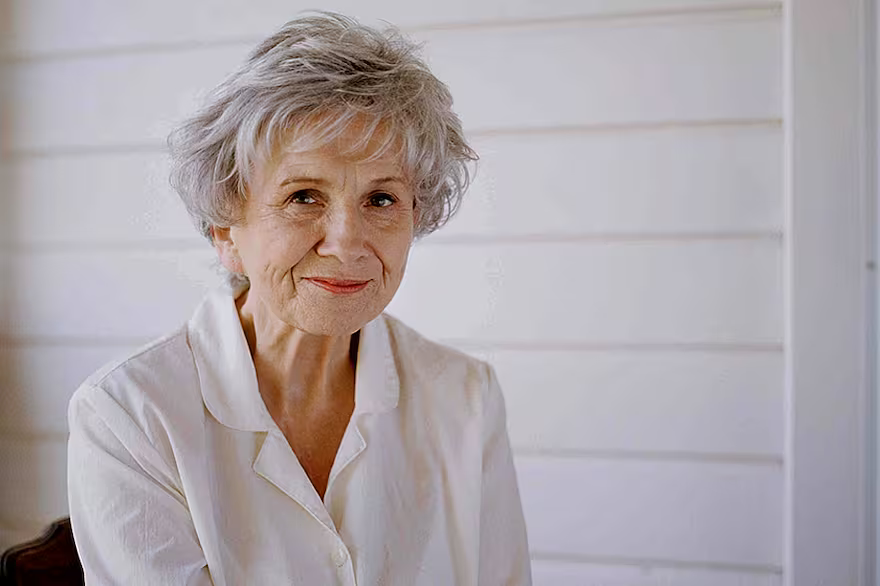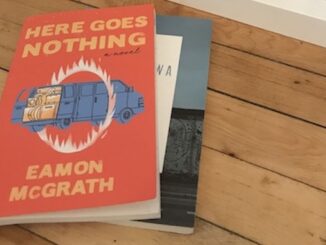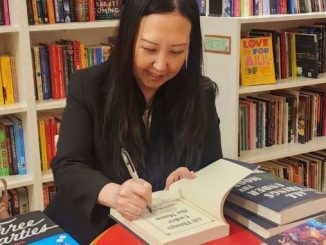My favourite stories by Alice Munro could not be further removed from my own experience.
“Red Dress—1946” (included in her first short story collection, Dance of the Happy Shades (1968)) and “The Bear Came Over the Mountain” (from Hateship, Friendship, Courtship, Loveship, Marriage (2001)), are about the lives of, respectively, an adolescent girl and an elderly woman. In one, a shy small-town girl marvels at the experience of dancing with – and then being walked home by – a boy from school. In the other, a woman with Alzheimer’s slowly drifts away from her husband – and towards a fellow (male) resident at a nursing home – in a studied meditation on ageing and memory, one which would later be adapted for the big screen in Sarah Polley‘s excellent Away From Her (2006).
Munro’s genius – one she shared with the likes of Chekhov, O’Connor, Joyce – was in finding something universal in the specific, of making it possible to understand, even identify with, characters, places, milieus her readers may never see or experience. Munro’s legions of fans – including the Swedish Academy, which awarded her the Nobel Prize in Literature in 2013 – may come from vastly different backgrounds, but they all have in common an admiration for this unassuming Ontario writer who captured the lives of girls and women with such extraordinary precision and feeling.
Munro’s passing – she died at her home in Port Hope, Ontario on May 13, 2024, at the age of 92 – is a momentous loss not only for Canada, but for all world literature.

BOYS AND GIRLS
Alice Laidlaw was born on July 10, 1931 in rural Wingham, Ontario, population 2,500. (Not much has changed since then: today, Wingham’s official census tally is 2,934.) The year she was born, R.B. Bennett was prime minister, George V king, and Canada a decade out from one world war, with a second on the horizon.
Munro was not the only future literary icon born that year: in January 1931, a very different sort of writer was born on St. Urbain Street in Montreal. But Mordecai Richler’s and Alice Munro’s paths to literary stardom could not have been more different. And their respective paths tell us a lot about the world into which Alice Munro was born, and to which she responded so eloquently.
When Richler was nineteen years old, he departed for Paris, inspired by self-styled macho authors like Hemingway and Fitzgerald. When Munro was nineteen, she married a university classmate – James Munro – dropped out of school, took his name, and became a housewife, ultimately raising three daughters. Before she married, Alice Munro had been studying journalism and English at the University of Western Ontario, on scholarship.
Richler’s first major success, The Apprenticeship of Duddy Kravitz (1959), came after a decade’s worth of journalism in the male-dominated bullpens of various North American magazines. Munro’s first success, nearly a decade after Richler, was 1968’s Dance of the Happy Shades, a collection of stories written in fits and starts over the course of fifteen years raising children, assisting with her husband’s bookstore (which is still standing), and fulfilling the self-described role of “B-minus housewife”.
DEAR LIFE
But it was those very social expectations which may have sidetracked Munro’s career which ultimately came to define the career itself. In her stories, Munro forcefully responds again and again to all those things a (male-dominated) society demands of its women, even as she refrains from celebrating or criticising the paths taken by any one girl or woman. Alice Munro may not have described herself as a feminist writer, but her writings evince a clear belief in the ability of women and girls to find meaning in whatever it is they do – from domesticity to the so-called learned professions; housewife to CEO – provided, at least, they are given a choice. (Her protagonists are certainly far more “normal”, i.e., socially acceptable, than the nonconformists and eccentrics of Flannery O’Connor, a fellow master of the short story.)
At her best, Munro did what Chekhov and a handful of others managed to do: tell something very personal, drawn from a very specific place and time, that manages to reveal something, if not always profound, then identifiably familiar about the human condition. Just as I have never been a Russian estate manager, I do not know what it is like to be a housewife in 1950s Huron County, Ontario. And yet, because of Munro, I have a feel for what that is, the aches and the longings of it, which, as it turns out, are not so dissimilar from the aches and longings felt by all of us.
TOO MUCH HAPPINESS
Over the course of her illustrious career, Munro saw multiple stories adapted for the screen, including the Oscar-nominated Away From Her (2006), Martha, Ruth and Edie (1988, an anthology film adapting several stories), Edge of Madness (2002, based on “A Wilderness Station”), and, with its titled abbreviated, Hateship, Loveship (2013). She won multiple Governor General’s Literary Awards (1968, 1978, 1986), the O. Henry Award for Short Fiction (2006, 2008, 2012), the Man Booker International Prize (2009), and is one of only two Canadians to win a Nobel (the other being the decidedly American Saul Bellow, nevertheless born in Montreal).
At the time Munro was made laureate, the Nobel Committee called her the “master of the contemporary short story”, praising her “minimalist style… clean, transparent, subtle and stunningly precise. It is a challenge to find an unessential word or a superfluous phrase. Reading one of her texts is like watching a cat walk across a laid dinner table.” She would probably chuckle at the amount of purple prose deployed in her honour these past few weeks.
Not that much could faze her. The Nobel was joined by other honours – Knight of the Order of Arts and Letters (France), Honorary Member of the Academy of Arts and Letters (U.S.) – though none seem to have had much impact on who she was and how she chose to live her life. Munro lived out her days in various small towns across Ontario, largely eschewing public appearances – the Nobel Committee had trouble reaching her back in 2013 – and continuing to focus on friends and family, albeit as the only person from Wingham, Ontario to receive a dedicated stream of fan letters.
HAPPY SHADES
Towards the end of “Red Dress—1946”, the narrator, a teenage girl, finds herself being walked home by a boy who barely seems to register her presence:
The boys were having an argument about a hockey game, which Lonnie and I could not follow. Then we separated into couples and Raymond continued with me the conversation he had been having with Harold. He did not seem to notice that he was now talking to me instead. Once or twice I said, “Well I don’t know I didn’t see that game,” but after a while I decided just to say “H’m hmm,” and that seemed to be all that was necessary.
What comes next – arriving at her front door, he “leaned towards me and kissed me, briefly, with the air of one who knew his job when he saw it, on the corner of my mouth.” – comes as no less a surprise to the narrator as to the reader.
It is, in one sense, a violation: like too many boys and men before (and after) him, Raymond has given no thought to the needs or interests of his female companion, kissing her out of a sense of entitlement, if nothing else. But Munro’s teenage narrator is oddly thankful, seeing this moment as a kind of release: between the kiss, the dance, and being walked home, she feels as if she has accomplished something, fulfilling what society, and in particular her “doggedly expectant” mother, demands of her. The phrase “my life was possible” appears here, capturing in four words what takes other writers a novel to express.
But Alice Munro, too wise a writer even in this early story, ends on a note of ambiguity. The girl, after swearing to herself she will not tell her mother what occurred, pauses:
I went around the house to the back door, thinking, I have been to a dance and a boy has walked me home and kissed me. It was all true. My life was possible. I went past the kitchen window and I saw my mother. She was sitting with her feet on the open oven door, drinking tea out of a cup without a saucer. She was just sitting and waiting for me to come home and tell her everything that had happened. And I would not do it, I never would. But when I saw the waiting kitchen, and my mother in her faded, fuzzy Paisley kimono, with her sleepy but doggedly expectant face, I understood what a mysterious and oppressive obligation I had, to be happy, and how I had almost failed it, and would be likely to fail it, every time, and she would not know.
It’s an equivocal note to end on, and one that continues to haunt me even all these years after I first read it.
I am not that girl, and the mysterious and oppressive obligation she carried in 1946 rural Ontario is far removed from any obligations I carry in my life. But that feeling – of failure, of knowing I will fail again, and that those who love me would not know – is all too familiar, and all too painfully human.
That, among so many other things, was Alice Munro’s gift: to make us feel like this girl – and so many other girls – who resembled Munro in certain ways, and who, much to our surprise, resembled us when we least expected it.



